Stainless Steel RTOs for Ethanol Emissions and Odors
Comments Off on Stainless Steel RTOs for Ethanol Emissions and Odors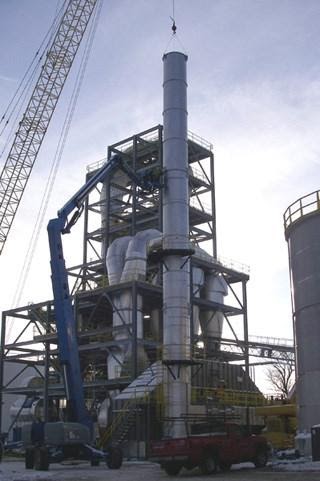 The Challenge
The Challenge
A 42 million gallon expansion at an ethanol production plant in the Midwest was certain to put the dry mill out of compliance for emissions such as Hazardous Air Pollutants (HAPs), Volatile Organic Compounds (VOCs), carbon monoxide (CO), nitrogen oxides (NOx), and particulate matter (PM). In general, ethanol production facilities in the United States are permitted to operate under a ‘minor source’ status as long as the total tonnage of key pollutants are below the 100 tons (named sources) or 250 tons (non-named sources) per year limit. However operating restrictions, penalties and fines, as well as community pressures are forcing many plants to strive for the lowest possible emission levels, enabling future capacity expansions.
The Solution
Anguil was awarded a multi-million dollar contract to assist the ethanol plant in meeting Environmental Protection Agency (EPA) regulatory requirements.
The Result
Known for their low operating cost and high destruction rate efficiency, the Anguil Regenerative Thermal Oxidizer (RTO) was selected as the best available control technology for the application. The pollution control device consists of two side-by-side Anguil RTOs handling a process volumetric flow of 120,000 SCFM (Standard Cubic Feet per Minute) (192,600 Nm3/hr). The system will achieve greater than 99% destruction rate efficiency for air pollutants and odorous emissions with 95% thermal energy recovery, ensuring low fuel usage. Portions of the equipment are constructed of 304-stainless steel to protect against corrosion from the ethanol process stream. The project scope consists of equipment design, manufacturing, installation supervision, process integration and start-up.
While several options and suppliers were considered, Anguil was awarded the contract after the Midwest producer evaluated system reliability, capital costs, destruction rate efficiency and operating cost estimates.
Keeping Ethanol Production Green
Comments Off on Keeping Ethanol Production Green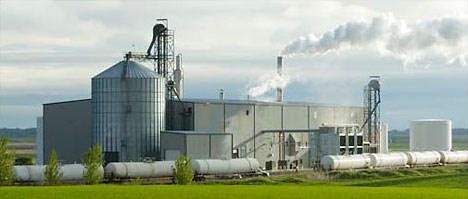 The Challenge
The Challenge
In an effort to reduce the world’s dependence on fossil fuels, there has been a major push towards alternatives. Ethanol has been at the forefront of this movement because it reduces greenhouse gas emissions from automobiles and its production has a positive net energy balance. The homegrown fuel also reduces the need for imported oil from sometimes unfriendly and unreliable supplier nations.
Ethanol is produced by fermenting and distilling starch, creating a 200-proof alcohol suitable for combustion in a vehicle. When processing corn, only 70 percent of the kernel is made into ethanol; the remaining fats, proteins, fiber, oils and minerals are referred to as distiller’s grain (DG). If a production plant is not very proximate to dairy operations or other significant livestock feeding needs, it will have to dry the DG in order to prevent spoilage during transport to more distant regional markets. Operating restrictions, penalties and fines, as well as community pressures, are forcing many plants to strive for the lowest possible emission levels from their dryers, enabling future capacity expansions.
Since air permits are granted on a facility-wide basis, when developing, designing and permitting ethanol production facilities, selecting the most appropriate process equipment as well as air pollution control equipment is critical. Some unique DG dryer designs are steam-heated or compressed air-based, but the vast majority of installed dryers are heated with natural gas. Regardless of the dryer type, volatile organic compounds (VOCs), odors and aerosols are emitted from the drying activity. By far the most commonly installed technology for this critical emissions source is some form of efficient thermal oxidation. Most of the major ethanol design firms incorporate thermal oxidation of this exhaust stream into their plant designs, and most state air permitting agencies require it.
 The Solution
The Solution
Process configurations & air permit implications
Selecting a dryer technology and its corresponding pollution control equipment often is the underlying decision for determining air permitting major source status. Prevention of significant deterioration (PSD) thresholds are now 250 tons per year (tpy) per pollutant facility-wide, since the EPA changed its interpretation of PSD rules for ethanol plants, in 72 FR 24060, on May 1, 2007.
In some non-corn-belt areas of the country where ethanol plants are now being proposed, such as those in ozone non-attainment areas or transport regions, major source thresholds are as low as 50 or even 25 tpy of VOCs to trigger non-attainment New Source Review (NNSR) permitting. When combustion emissions from boilers, emergency generators, fire water pump engines and load-out flares are added to those from the dryer and thermal oxidizer, one can envision why these decisions are critical.
NNSR permitting involves determining and installing the lowest achievable emissions rate (LAER), control technology, obtaining emissions offsets, and analysis of alternatives for the entire development project. PSD permitting involves dispersion modeling, best-available control technology (BACT) determination and commitment, and other impact analyses. Both NNSR and PSD permitting involve additional expense and longer permitting timelines, neither of which finds fondness with ethanol developers. Efficient, properly tuned thermal oxidizers are generally considered to meet BACT and LAER requirements, but there is surprisingly little history in the EPA’s RACT/BACT/LAER Clearinghouse database[1], since most ethanol developers to date have sought to avoid NNSR and PSD permitting by maintaining emissions below the threshold levels.
Abatement equipment selection
Some ethanol facilities in the upper Midwest were originally constructed without thermal oxidizers. However, odor complaints and EPA consent orders forced the installation of oxidizers, and hence some form of thermal oxidation is now a part of any new ethanol plant design involving a dryer. Certain plants with solid fuel boilers (often major sources) may vent the dryer exhaust into the boiler for thermal destruction. Others may recover some energy from direct-fired thermal oxidizers by generating steam.
In general, the following two technology solutions have been considered preferred for the ethanol plant DG dryer emission control:
Regenerative thermal oxidizer (RTO):
- Destruction Efficiencies of 98 to 99% for VOCs, hazardous air pollutants (HAPs) and CO
- Designed to handle a wet air stream with some particulate.
- Pre-filters available for higher levels of particulate.
- Thermal energy recovery of 95 percent insures low fuel usage, and low NOX production.
- Fuel injection system further lowers NOX.
Direct-fired thermal oxidizer (DFTO) with waste heat boiler:
- Designed to oxidize 99+ percent of VOCs, HAPS, CO and organic particulate without obstructions, eliminates the potential for plugging.
- Generates steam for use in the process.
- Can reduce overall capital cost of plant and air emissions.
- Optional turbine produces power for driving electric motors or for distribution within the plant.
The Result
A natural gas RTO may have the highest efficiency, the lowest emissions and a lower total installation cost versus other options. A natural gas RTO may allow a larger capacity plant to be constructed (greater than 100 MGY) while remaining a minor source, but most other options will trigger major source permitting. Trade-offs are between capital expenditures and operating expenses, as well as a shorter timeline to construction, versus potential future competitive advantages. A good natural gas supply deal is a must, with some portion of the net input reserved for hedging on the spot market.
An ethanol developer’s speed-to-market, permitting timeline and expenses, material logistics, feedstock, energy source, and selected co-products all relate to the dryer type and air pollution control technology decisions.
Several other parameters need to be considered to evaluate the selection and design of a fully integrated air abatement system, including regulatory requirements and emission characteristics for VOCs, NOX, CO and HAPs. Other parameters include the following process characteristics:
- New or existing plant
- Airflow requiring treatment
- Steam requirements and cost to produce
- Power availability and cost to distribute
Environmental impact
According to the Department of Energy’s Argonne National Laboratory, ethanol-blended fuels reduced CO2-equivalent greenhouse gas emissions by 7.8 million tons in 2005, which had the equivalent effect of removing the annual greenhouse gas emissions of over 1 million automobiles from the road. Many agree that ethanol is a cleaner-burning fuel than gasoline. With state-of-the-art control technology in place at ethanol plants, it can be ensured that production does not counteract the positive impact of this alternative fuel.
- Visit http://cfpub1.epa.gov/RBLC/ to learn more about the RACT/BACT/LAER Clearinghouse.
Waste Heat Generates Steam and Savings
Comments Off on Waste Heat Generates Steam and Savings The Challenge
The Challenge
A coil coating facility purchased a new 15,000 SCFM (24,075 Nm3/hr) Regenerative Thermal Oxidizer (RTO), which had a nominal heat transfer efficiency rate of 90% thermal energy recovery. It was designed with supplemental fuel injection (SFI), which is used during low VOC loading conditions to help save fuel cost. The facility was looking for additional ways to decrease their exhaust air temperature and reduce operating costs.
The Solution
The high exhaust temperature (above 650°F) and large airflow (12,650 SCFM, 20,303 Nm3/hr) in the oxidizer exhaust stack provided the customer an opportunity to add energy recovery measures to further optimize their process and decrease their operating expenses. Because their process required a significant amount of steam, it would likely provide the quickest payback for an energy recovery project.
The Result
Anguil Environmental installed an air-to-steam waste heat recovery boiler to recover exhaust waste heat from the natural gas fired thermal oxidizer and produce 25 psig of steam. The boilers use X-ID tubing for enhanced heat transfer through the helical ribs on the inside of the tubes.
The waste heat boiler package is a skid-mounted unit, with forced circulation, fire tube, and heat recovery steam generator. The unit has automatic, modulating, exhaust gas bypass that is controlled by steam pressure. A boiler feedwater and blowdown separator was included as part of the package.
Installing the waste heat boiler system recovered about 2.58 MM BTU/hr of energy, lowering the stack temperature to 338°F. The addition of the waste heat boiler on this application saved the facility $216,770 per year. The total payback period for this project was less than six (6) months.
Oxidizer Energy Recovery Options
Comments Off on Oxidizer Energy Recovery Options The Challenge
The Challenge
The mainstream media today is full of allusions to energy awareness and conservation. Just as visible these days are media references to astronomical dollar figures that can boggle the mind. This article does not seek to break out of that mold, but rather to conform to it, as Oxidizer Stack Heat Recovery offers a tremendous opportunity for both energy conservation and energy cost reduction.
The Solution
Consider the following: at any hour of the day there are likely to be more than 10,000 oxidizer systems in service, using a high temperature reaction chamber (with or without catalyst) to treat the exhaust gases from a wide range of industrial processes. The final component of nearly all of these oxidizer systems is an exhaust stack, where the treated exhaust gases are released to the atmosphere at elevated temperatures.
Historically, oxidizer systems have been sized to treat exhaust air flows from 100 SCFM (Standard Cubic Feet per Minute) (160.5 Nm3/hr) up to several hundred thousand SCFM. But conservatively, the average oxidizer system airflow processing capability (i.e. “size”) can be estimated to be between 15,000 and 20,000 SCFM (24,075-32,100 Nm3/hr).
Now, considering these 10,000 stacks emitting hot, treated gases to the atmosphere around the clock; if heat recovery equipment capable of dropping the exhaust stack temperature by 100 ˚F could be installed into each one of them, this would lead to an overall value of over 18 billion BTUs (British Thermal Unit) per hour of energy conservation!
Assuming $10/MM BTU and year round operation – this equates to recovering over $1.5 billion (US Dollars) worth of energy per year!
Taking this into account, it is no surprise that a wide range of stack energy recovery options have been developed and marketed to end-users of oxidizer systems. This article will discuss three important aspects of energy reclamation from hot oxidizer stacks:
- Energy reclamation from oxidizer stacks is one of three potential areas of optimization for oxidizer systems.
- There are distinct challenges that must be addressed in the process of evaluating potential energy savings options.
- There are multiple potential equipment options for this application, each with its own benefits and limitations.
 The Result
The Result
The ABC’s of Oxidizer Stack Energy Recovery
Oxidizer Energy Recovery Options
Using ABC’s in the title of this section is actually a misnomer. Truthfully, the letters A and B should be set aside and the caption should read – The CDE’s of Oxidizer Stack Energy Recovery. The reason for this is twofold:
First of all, any plan for recovering waste heat in the exhaust stack of an oxidizer system is already a Plan C. For anyone taking a hard look at optimizing the energy efficiency of an oxidizer system as a whole, Plan A should consider ‘upstream’ opportunities. For example, retrofits that reduce overall airflow to the oxidizer system and/or increase the concentration of solvents to be treated. Plan B should focus on the internal TER (Thermal Energy Recovery) of the oxidizer system itself. After airflow reduction, maximizing the internal energy recovery of an oxidizer system will almost always lead to the best project payback.
Hence, it follows that energy recovery in the exhaust stack of the oxidizer is Plan C. Now calling it Plan C is by no means meant to downplay the opportunities associated with oxidizer stack energy recovery. The only intent is to fit the concept into the greater framework of energy usage in the oxidizer system as a whole. There are many reasons why Plan A and/or Plan B as defined above may not be attractive or even feasible, making Plan C: Energy Recovery in the Oxidizer Exhaust Stack, the best overall choice for energy conservation efforts.
The second reason that the letters C, D and E are a better fit for the title of this section is that those three letters represent the challenges associated with energy recovery efforts in oxidizer exhaust stacks, namely:
- CAPTURING the energy from the stack itself
- DELIVERING the energy back into the plant cost-effectively
- EMPLOYING the recovered energy effectively inside the plant
Following is a brief discussion of each of these challenges along with the different options for recovering oxidizer stack heat.
Challenge #1: Capturing the Energy
Of the three challenges, the first – Capturing the Energy – is usually the easiest to evaluate and estimate. By simply knowing the airflow and temperature of the exhaust gases in the oxidizer stack, suppliers of energy recovery equipment can quickly begin to model an appropriate device for reclaiming energy effectively. It is often during this first challenge that the overall opportunity for yearly savings is also quantified.
The more information that an oxidizer end-user can provide at this juncture, the more realistic the opportunity analysis can be. At a minimum, those considering stack energy recovery should gather the following before beginning this process:
- Expected airflow and average temperature in the oxidizer stack
- Expected hours of operation per year
- Current energy rates for the plant (gas or oil and electric)
The first two items are often monitored already on a continuous basis in oxidizer data recorders. If that is not the case for a particular system, the most recent EPA (Environmental Protection Agency) stack testing data can be an excellent source for this information.
Two other issues for consideration during this phase of an evaluation are:
Constituents in the exhaust gases (and especially their dew points): Any effort to reclaim energy in the exhaust stack of an oxidizer will lower the oxidizer exhaust gas temperature, bringing with it the potential for condensation of acids. Suppliers of energy recovery equipment will typically take care to ensure that final stack temperature is above any acid dew points. Given the typical solvent laden exhaust from printing presses, this is rarely an issue of concern for oxidizer systems in the flexographic printing industry.
Adding energy recovery equipment to an oxidizer exhaust stack will also come with a system back-pressure penalty. The existing oxidizer fan will usually be tasked with pushing or pulling air through the ‘hot side’ of the added heat recovery component. To keep overall project payback attractive, the goal is usually to choose energy recovery equipment that will limit the added system back-pressure to an amount that the existing oxidizer system fan can handle without major modification. Therefore, knowing the additional capacity available in the oxidizer system fan will help narrow down which cost-effective options for energy recovery are feasible.
Challenge #1 for a typical application may look like this:
Consider a flexographic printer with a ten year old 20,000 SCFM (32,100 Nm3/hr) Regenerative Thermal Oxidizer (RTO). The combined exhaust from all dryers and capture hoods routed to the RTO is 20,000 SCFM (32,100 Nm3/hr) at approximately 150˚F (65.5˚C). The average exhaust temperature from the RTO is 275˚F (135˚C).
Plan C – A 50% effective heat exchanger installed in the oxidizer exhaust stack to transfer the waste heat to air or fluid would drop the stack temperature by approximately 125˚F (51.7˚C) – capturing approximately 2.7 MM BTU/hr. If this energy was 100% useful inside the plant and the plant operated around the clock, this could lead to a yearly savings of up to $225,000.00. A payback of one to two years is certainly possible for a project of this nature.
By comparison:
Plan A – reducing airflow to the RTO by 10% could save approximately 0.3 MM BTU/hr or up to $25,200.00/year. This could likely be accomplished with very little capital investment at all. A payback of less than six months is possible for this option.
Plan B – for the data presented, this RTO is operating with an internal thermal energy recovery (TER) of approximately 92%. Installing additional ceramic heat recovery media to raise the TER to 95% could save approximately 1.0 MM BTU/hr or up to $84,000.00/year. A payback of less than one year is possible for this option.
Challenge #2: Delivering the Energy Back into the Plant Facility Cost Effectively
As seen in Challenge #1, sizing energy recovery equipment and estimating the overall savings opportunity with oxidizer stack energy recovery are not difficult tasks. To take an opportunity analysis and turn it into an actual payback period however, one has to determine the cost of installing the equipment and providing the infrastructure for delivering captured energy back to the plant.
For a cursory analysis, some will take the cost of the energy recovery equipment and double it, calling that the estimated cost of installation. (i.e. Total Estimated Cost = One Part Equipment Cost + Two Parts Installation Cost) This can provide for a quick check of whether a particular idea merits additional investigation. To obtain true payback numbers then a site visit by different tradespeople to estimate the overall cost of energy recovery system installation will be necessary. Fans and/or pumps, control valves, thermocouples, etc. will all need to be both mechanically installed and electrically wired to an existing or new control system. This is often the challenge where the overall project feasibility hangs in the balance.
Challenge #3: Employing the Recovered Energy Effectively inside the Plant Facility
The final challenge is also extremely important for optimizing energy recovery project payback. Ideally, the oxidizer end-user should look for ways in which recovered stack energy can be used in the same process that the oxidizer is connected to. This typically provides the best payback because there are energy demands by that process at nearly all times that oxidizer waste heat is available. In contrast, projects focused on recovering oxidizer exhaust stack energy to help heat a facility, for example, may only be useful for part of the year.
Oxidizer Stack Energy Recovery Options
Oxidizer stack heat has been recovered to perform a wide variety of functions in the plant environment.
Air-to-air heat exchangers have been used to provide pre-warmed fresh air back to process ovens, dryers and/or plant make up air units.
Air-to-fluid heat exchangers have been used to transfer oxidizer stack heat to boiler feed water, plant makeup water, process water, glycol and other thermal fluid loops.
In extreme cases, waste heat boilers have been used with oxidizer stack heat to create steam.
And on the horizon, heat-to-power systems are in development for reclaiming oxidizer stack heat and creating electricity.
One additional option that has been used sparingly is taking hot oxidizer stack air directly back for use in production processes. This is sometimes referred to as Direct Heat Recovery, while the options mentioned above would be termed Indirect Heat Recovery. Direct Heat Recovery from oxidizer stacks is generally shied away from due to the risks of introducing products of incomplete combustion back into a plant environment or the risk of oxidizer “oven dirt” contaminating product, but there are limited cases where this form of oxidizer stack energy recovery has been used effectively.
Each of these options for recovering heat from oxidizer exhaust stacks can be considered within the framework of the three challenges discussed previously.
Air-to-Air Heat Recovery
Probably the most common energy recovery product applied to oxidizer stacks is an air-to-air heat exchanger. Be it a shell-and-tube or plate type heat exchanger, there is a cold side air stream (typically fresh air) and a hot side air stream (typically the oxidizer exhaust) that are used for heat transfer.
Air-to-air heat exchangers have been integral to oxidizers themselves for decades so it is a well-known technology for oxidizer manufacturers to incorporate into an overall system. The programs for sizing air-to-air heat exchangers are quick and easy to use. There are a wide variety of footprints and physical layouts for ease of installation. There are also many low back pressure models that work well with existing oxidizer system fans.
The limiting factor for air-to-air heat recovery in oxidizer exhaust stacks is Challenge #2: Delivering the Energy Back into the Plant Facility Cost Effectively. With air-to-air heat recovery, insulated ductwork is required to transport captured heat back into the facility. Costs for running ductwork in a plant vary widely and can also add up very quickly. The best applications are those with short duct runs for returning heated air.
Air-to-Fluid Heat Recovery
Air-to-fluid heat exchangers are the second most common energy recovery product for oxidizer stacks. As the name implies, heat is transferred from the hot oxidizer exhaust air (again the hot side air stream) to a circulating fluid (the cold side stream). This is typically accomplished by passing the hot air over a coil containing the fluid to be heated. As with air-to-air heat recovery there are a variety of low back pressure designs that can allow installation into an oxidizer exhaust stack without adversely affecting the oxidizer system.
Because piping is less expensive than ducting, air-to-fluid heat recovery has a definite advantage over air-to-air heat recovery when considering Challenge #2: Delivering the Energy Back into the Plant Facility Cost Effectively. However, unless the heated fluid is used directly back in the process that the oxidizer is connected to, Challenge #3: Employing the Recovered Energy Effectively inside the Plant Facility, can be more difficult to address with air-to-fluid heat recovery. Meeting this challenge requires a detailed analysis of the demands for energy in the fluid system versus the availability of waste heat in the oxidizer stack. For example, in some plants the biggest hot water demands come in shutdown situations when the oxidizer is not running.
Air-to-Steam Heat Recovery (Waste Heat Recovery Boilers)
When the solvent laden air sent to an oxidizer system is sufficiently rich, the oxidizer’s internal heat recovery component may need to be partially bypassed or forgone completely. This leads to higher than normal oxidizer stack temperatures and allows for additional options in heat recovery equipment. One such option is a waste heat recovery boiler to recover oxidizer exhaust stack heat and produce steam. Waste heat recovery boilers are custom sized for a particular exhaust gas capacity as well as required steam pressure. A variety of systems are available in vertical, horizontal, single or multi pass configurations. Oxidizers on most applications rarely have the necessary solvent loading and corresponding exhaust stack temperatures to sustain this option.
Heat-to-Power
Sometimes referred to as cogeneration, heat-to-power is an emerging technology that is capable of sending kilowatts directly back into a facility for electrical power. The concept has been implemented on different applications throughout the world but is only now being integrated with combustion devices such as oxidizers. Heat-to-power systems can currently generate up to 100kw per hour from a modest heat source. However, the payback is normally greater than three years, the value most companies use for acceptable capital investment. As electricity costs increase and greater efficiencies are achieved with the technology it will be a very attractive option in the near future. Today, heat-to-power is not necessarily a cost reduction strategy but rather a green initiative that could be used to promote a company as a leader in energy conservation.
Oxidizer stacks represent a significant opportunity for the reclamation of energy. This applies to all oxidizer systems – including both the aging catalytic oxidizers popular in the industry years ago as well as the newer, high efficiency regenerative thermal oxidizers (RTOs) being supplied today. Achieving a cost-effective installation of energy recovery equipment with an attractive payback is not without challenges, but those challenges are being met today in a variety of ways.
Air-to-Water Heat Exchanger Reduces Operating Costs by $120,000 per year
Comments Off on Air-to-Water Heat Exchanger Reduces Operating Costs by $120,000 per year The Challenge
The Challenge
This pharmaceutical company had a 5,000 SCFM (8,025 Nm3/hr) oxidizer that they were looking to relocate to another facility across the United States. The destruction rate efficiency and heat recovery expectation at the new location differed from the original design conditions at the current facility.
The Solution
An Anguil field service engineer went to site to inspect the unit. A report detailing the current condition of the oxidizer at its current location was generated as well as a written procedure for the proper dis-assembly and reassembly of the equipment. The service engineer evaluated the unit and made recommendations outlining the modifications necessary to make the unit run at the new facility’s desired destruction efficiency rate and the energy requirements.
The Result
Anguil worked closely with the customer to modify and upgrade the system based on the detailed site inspection report. The work included a control package upgrade and a new hot gas bypass damper.
To address the energy recovery requirements at the new facility, a new economizer was installed between the oxidizer and exhaust stack to transfer heat to water. The exhaust heat from the stack was transferred to the Anguil economizer which in turn created hot water. This otherwise lost energy is captured and can be used in various applications such as boiler feedwater, cold makeup water, process water, glycol, and thermal fluids.
The stainless steel system is a tube and fin style heat exchanger with access doors for inspecting and cleaning of the tubes. The exhaust flow from the catalytic oxidizer is 5,400 SCFM (8,667 Nm3/hr) and the temperature is 450°F (232°C). Roughly 160 GPM of water is heated to 140°F (60°C) with the economizer. The total energy recovered is 1.43 MM BTU/hr or an estimated total savings of $120,512 per year.
A Competitive Advantage
Comments Off on A Competitive AdvantageIn the face of rapid industry advancement, semiconductor chip manufacturers are continually looking for an edge on the competition. Historically, that requires them to stay current with the latest trend in wafer sizes but it can also be achieved through innovative pollution control technologies and techniques at their production plants.
At Anguil, our customers know they can trust our team to develop and deliver quality solutions to their unique environmental challenges. In one case, a large semiconductor chip fabricator wanted to reduce their environmental impact, maintain their productivity, save on operational costs, and conserve valuable floor space. We are experts in environmental efficiency through custom design and manufacturing of air pollution, water treatment, and energy recovery systems.
Project Highlights:
- Client needed an abatement system with over 100,000 SCFM (160,500 Nm3/hr) volume processing capacity and over 98% VOC removal efficiency
- Anguil compiled a system of a rotor concentrator wheel, custom-designed thermal oxidizer with a destruction efficiency rate (DRE) of >99.5%, and a specialized heat exchanger
- Each system was able to meet and exceed the processing capacity and destruction efficiency requested, with the processing capacity double that of the two previous systems combined
The Challenge
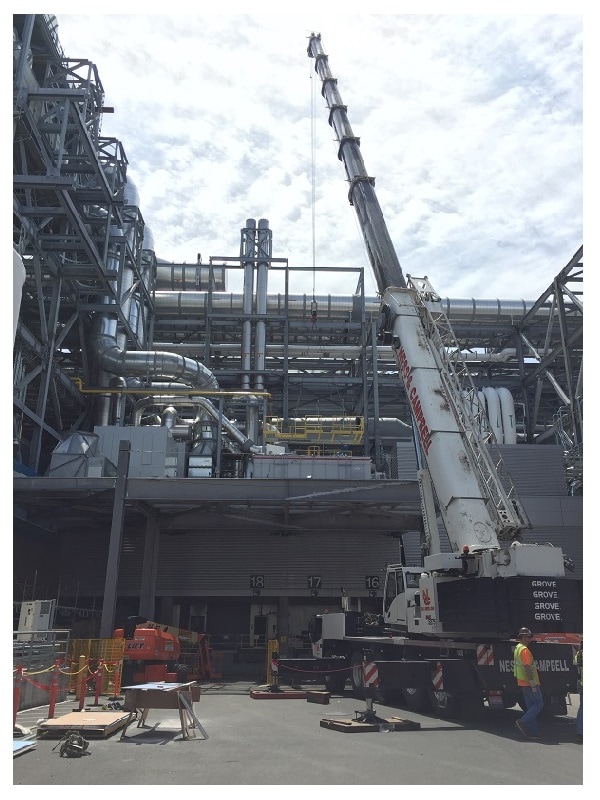
The customer approached our team with a request for a new abatement system for their plants. They came to us to stay ahead of their competition by tackling the challenge of reducing their environmental impact without sacrificing their facilities’ productivity and output. While they were currently employing the use of two systems, each with capacities for less than 50,000 SCFM (80,250 Nm3/hr), they were looking for a more efficient and effective solution. Ultimately, they were seeking a system that doubled their SCFM volume processing capacity with a 98% VOC removal level.
Their exact system requirements were as follows:
- >100,000 SCFM (160,500 Nm3/hr) volume processing capacity in a single system with the same footprint as the two existing pollution control devices
- >98% VOC removal efficiency
- No upstream pressure fluctuations
The Solution
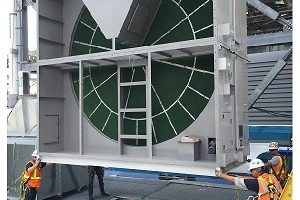
Once fully assembled, all three systems were installed on mezzanine levels of the existing plants. After installation, our technicians completed final commissioning and provided comprehensive operator training. Ultimately, the customer was left with a system that met their needs and a team trained to properly use that equipment.
The Result
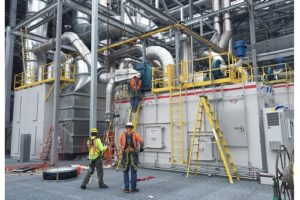
Additionally, by replacing their old air pollution systems with our more effective and efficient system, the customer was able to save on floor space and operational costs.
Learn more about Anguil’s pollution control solutions in this industry.
Wind Turbine Manufacturer Implements Clean Air Initiative
Comments Off on Wind Turbine Manufacturer Implements Clean Air Initiative The Challenge
The Challenge
When you think about generating electricity from wind, clean energy comes to mind. However, the wind turbine production process can be a major source of air pollution without the proper controls in place. Manufacturing and painting the blades, towers, and nacelles requires composite construction material and solvent-based coatings. The potential to emit Volatile Organic Compounds (VOCs) and Hazardous Air Pollutants (HAPs) such as xylene, ethyl benzene, styrene, and phenol into the atmosphere is a major concern for communities and regulatory agencies.
The Solution
One of the world’s largest turbine manufacturers is doing their part to keep wind power a truly clean source of energy. With the expansion of several new production lines, the company enlisted help from Anguil Environmental Systems to ensure proper air pollution control from their component painting processes in The United States.
 The Result
The Result
Approximately 40,000 SCFM (64,200 Nm3/hr) of solvent-laden air is diverted from multiple paint booths to an Anguil Regenerative Thermal Oxidizer (RTO), which destroys over 99% of the air pollutants. Similar to the RTO shown here, this system incorporates pre-filters to stop overspray from plugging the oxidizer ceramic media. Designed for 95% thermal efficiency, the Anguil RTO can self-sustain at low concentration levels, which reduces the need for auxiliary fuel.
Demand for renewable energy is on the rise, and experts predict that 70 to 80 new wind turbine blade factories could come online throughout the world in the next decade. With multiple systems on applications such as this, Anguil’s experience makes them the preferred vendor for emission control systems in the wind turbine market.
Styrene Emissions: Catalytic Oxidizer with Concentrator
Comments Off on Styrene Emissions: Catalytic Oxidizer with Concentrator The Challenge
The Challenge
The world’s largest button manufacturer needed a pollution control system that would destroy styrene emissions and odors from a variety of plant processes. The plant was proactively seeking a cost-effective air pollution control solution to preempt future regulatory action. The main concern of the customer was the high operating cost of an emission control system.
The Solution
After thorough evaluation of several possible technology solutions, the company selected an Anguil abatement device to treat their styrene emissions. Anguil recommended a uniquely efficient solution in an Emissions Concentrator coupled with a Catalytic Oxidizer. A key factor in this decision was the emission concentrator’s ability to lower the volume of air that needed treatment by achieving a 10 to 1 flow rate reduction. Anguil provided the customer with a static pilot test to prove the effectiveness of the concentrator rotor on styrene. The successful results from the static test ensured the customer’s confidence in the new application of the concentrator technology to control styrene emissions.
Three main considerations guided the design of this solution: the need for an emission control system with low operating costs, the control of the high volume, low volatile organic compound (VOC) concentration of the process air stream, and the unique characteristics of styrene.
Many of the processes that emit styrene, such as boat building and FRP production, have high air flows with low VOC and styrene concentrations. Button manufacturing presents a similar problem but on a slightly smaller scale. The plant’s airflows were approximately 15,000 SCFM (24,075 Nm3/hr) with styrene concentrations ranging from 50-200 ppmv. The customer considered a Regenerative Thermal Oxidizer (RTO) and a bio-filtration system as other possible solutions. While effective in destroying styrene, both of these would have been very expensive solutions because higher air flows result in higher costs for treatment technologies. The operating costs of the RTO and the biofilter were much higher than the chosen solution because these systems had to treat the entire 15,000 SCFM (24,075 Nm3/hr) of process air.
The Result
An emissions concentrator coupled with a catalytic oxidizer reduced the process air that needed to be treated by a factor of 10. The high volume airstream, approximately 15,000 SCFM (24,075 Nm3/hr) with 50-200 ppmv of VOC, is passed through the emissions concentrator rotor where the VOCs and styrene are adsorbed in the bed, purifying the high volume air. This high volume air is then exhausted to atmosphere. The concentrator rotor rotates continuously, transporting adsorbed VOCs into a desorption section where they are desorbed from the media with a low volume heated airstream. After being desorbed from the wheel, the air volume has been reduced from 15,000 SCFM (24,075 Nm3/hr) to about 1,500 SCFM (2,407.5 Nm3/hr) and the VOC concentration of the air stream is increased to about 500- 2000 ppmv. This low volume, high pollutant-laden air is then processed by the oxidizer. By isolating and treating the lower air volume, Anguil is able to provide a system with far lower operating costs than other emission control systems.
Anguil was able to further reduce the operating cost of the system by utilizing a catalytic oxidizer to destroy the concentrated, contaminated air stream. Anguil’s experience with styrene emissions has demonstrated the easily oxidizable nature of styrene in the presence of catalyst. Catalytic oxidation systems typically achieve greater than 99% destruction of styrene with relatively low temperature requirements. An Anguil Catalytic Recuperative Oxidizer designed for 1,500 SCFM (2,407.5 Nm3/hr) was installed to process the pollutant-laden airstream with minimal auxiliary fuel consumption.
The final design consideration was to address the unique characteristics of the styrene emissions. The customer was concerned with the possibility of styrene polymerization on the rotor and subsequent system failure. Anguil had performed extensive tests to establish that certain zeolite formulations function better than others in the presence of styrene and eliminate the possibility of polymerization. However, Anguil went to the next step in order to relieve the customer’s concerns. Working closely with one of their technology partners, Anguil ran several static (live) pilot tests to prove the effectiveness and reliability of the concentrator/oxidizer technology. This testing process convinced the customer to move ahead with the Anguil solution.
Another benefit to the customer of the concentrator/oxidizer system was low maintenance cost. The zeolite material has an expected life of 10 years under continuous operation. The easy regeneration and durability of zeolite provides considerable savings over the constant maintenance and replacement required of carbon beds. Additional maintenance savings come from the durable design of the emissions concentrator. The absorbent wheel is rotated with a simple motor and belt drive, reliable components that last at least five years and require minimal maintenance.
In order to expedite installation, Anguil assembled the entire system in its manufacturing facility, allowing for customer review and inspection prior to shipment. The system was then re-erected in the field and integrated into the customer’s process. Anguil’s combination of proven experience and technologically advanced air pollution control products have led to another satisfied customer.
Fiberglass Polymer Emissions: RTO Control Technology
Comments Off on Fiberglass Polymer Emissions: RTO Control Technology The Challenge
The Challenge
A producer and supplier of corrosion resistant piping systems was looking to improve the reliability and lower operating expenses of an existing air pollution control system at their facility. During their manufacturing process, centrifugally cast mortar pipe systems are reinforced with a fiberglass polymer. This makes the pipe ideally suited for most corrosive piping applications but also produces a significant amount of styrene emissions that need to be destroyed. Plant personnel knew that their existing 40,000 SCFM (64,200 Nm3/hr) fixed-bed concentrator and catalytic oxidizer could not handle future expansion plans and the decision was made to look for a replacement.
The Solution
After speaking with several vendors, the Regenerative Thermal Oxidizer (RTO) was selected as the best available control technology. It not only far exceeded the 95% destruction efficiency required in their permit but also dramatically reduced operating costs. The pipe manufacturer then identified what qualifications they were looking for in a solution provider:
- Styrene Experience
- Proven Performance
- Stable Supplier
- Cost-Effective Equipment
- Turnkey Capabilities
Anguil was selected based on their ability to meet these equipment and supplier requirements.
The Result
Anguil’s engineering staff worked closely with the customer throughout the design and manufacturing processes to ensure that the system precisely met their requirements and expectations. An Anguil Model 500 RTO (50,000 SCFM, 80,250 Nm3/hr) was selected based on the process airflow concentrations, destruction rate requirements, and for its overall energy-efficient operation.
Special considerations were taken to deal with the particulate in the process stream. A 48-cartridge collector was put upstream of the oxidizer to collect fiberglass pieces that could clog the RTO. Once filtered, process gases with Volatile Organic Compound (VOC) contaminants enter the oxidizer through an inlet manifold. Dual disk poppet valves direct this gas into energy recovery chambers where the process gas is preheated, then progressively heated in the ceramic beds as they move toward the combustion chamber.
The VOCs are oxidized in the combustion chamber, releasing thermal energy in the structured ceramic media beds that are in the outlet flow direction from the combustion chamber. These outlet beds are heated and the gas is cooled so that the outlet gas temperature is only slightly higher than the process inlet temperature. Fasting acting, vertical poppet valves alternate the airflow direction into the ceramic beds to maximize energy recovery within the oxidizer. The VOC oxidation and high energy recovery within the oxidizer reduces the auxiliary fuel demands and operating costs. For example, at 95% thermal energy recovery, the outlet temperature may be only 70`F (40`C) higher than the inlet process gas temperature with an RTO. The oxidizer can reach self-sustaining operation with no auxiliary fuel usage at low concentrations.
Allen Bradley Programmable Logic Controllers (PLCs) control the automatic operation of the oxidizer from startup to shutdown, so minimal operator interface is required. These controls also provide for remote telemetry to enable the system’s operation to be viewed and altered via a modem connection to reduce maintenance costs.
The customer is achieving 98% destruction rate efficiency and the oxidizer is operating extremely efficiently at 95% thermal rate efficiency. Low operating costs and equipment reliability have resulted in another satisfied Anguil customer.
Carbon Fiber: Oven Emission Control Strategies
Comments Off on Carbon Fiber: Oven Emission Control StrategiesThe Challenge
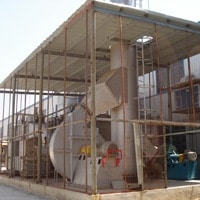
A carbon fiber company in the People’s Republic of China was faced with this challenge while designing a new facility and process line for their specialty fiber products. Company officials knew they would need a pollution control device that not only met the local regulations but also protected their employees and heavily populated neighborhood. The new line would include a furnace and oven with the potential to discharge significant levels of Carbon Monoxide (CO), Ammonia (NH3) and lethal amounts of Hydrogen Cyanide (HCN).
The Solution
There are two primary pollution control technologies applied downstream of the ovens and furnaces at carbon fiber processing plants. The industry has historically used dual stage, Direct-Fired Thermal Oxidizers (DFTOs) for emission control on the furnaces and Regenerative Thermal Oxidizers (RTOs) for oven exhaust treatment. Both technologies are capable of destruction removal efficiencies (DRE) over 99%, but the RTO has the advantage of very low operating costs.
When searching for an air pollution control partner, the carbon fiber processor looked for a vendor that not only had the necessary experience but also a local presence. Each producer’s fiber differs from those of its competitors, and the processing details that give each brand its signature characteristics should be considered when selecting the emission control device. The Anguil Asia teams located in both Taiwan and China demonstrated their understanding of the capture, control, and compliance hurdles that the processing plants face. Prior to equipment selection, Anguil ran an energy analysis at the facility which helped in selecting the proper technology based on destruction requirements, efficiency needs, and process parameters.
Anguil recommended a model 25,000 SCFM (40,125 Nm3/hr) RTO with several features that improved reliability, performance, and efficiency.
- The proprietary design has oversized valves, a fan, and a stack to handle the elevated temperatures coming from the process and to allow for future expansion.
- On most applications, airflow is generally pushed through an RTO, but this application was designed for an induced draft configuration. This ensures that all of the hydrogen cyanide emissions would be drawn into the oxidizer for destruction, protecting the company’s employees and neighborhood from a potentially lethal situation.
- A Supplemental Fuel Injection (SFI) system was included on the RTO for increased fuel efficiency and ultra low NOx emissions.
- The poppet valve design on the RTO operates without process interference at the oven.
The Result
Once fabricated, the Anguil RTO was installed and running in less than four weeks. It is currently achieving greater than 98% destruction removal efficiency with over 95% thermal heat recovery. The system is extremely efficient, self-sustaining at low emission loading, and requires very little supplemental fuel for destruction.
Anguil’s involvement didn’t stop at the oxidizer; they saw this emission control project as an opportunity to reduce operating costs for their customer. Ovens on a carbon fiber process can require a significant amount of natural gas to maintain temperatures from 392°F to 572°F (200°C to 300°C). A secondary heat exchanger made of 304 stainless steel was installed after the oxidizer to preheat the oxidation oven. The plate-type heat exchanger recovers 75% of the RTO exhaust, using that preheated air in lieu of ambient air for the oven. Initial estimates indicated a one year payback on the added capital equipment cost, but it actually took only 5 months.
The project resulted in an overall reduction of emissions and operating expenses for the carbon fiber company, and they are currently considering future green initiatives with Anguil.

 The Solution
The Solution The Challenge
The Challenge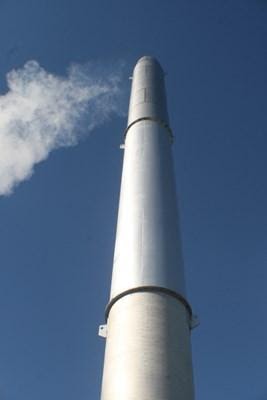 The Challenge
The Challenge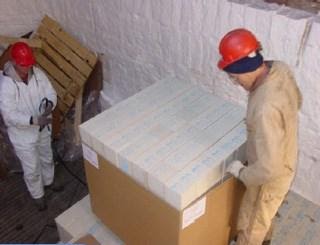 The Result
The Result The Challenge
The Challenge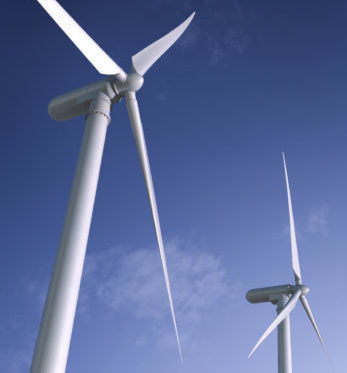 The Challenge
The Challenge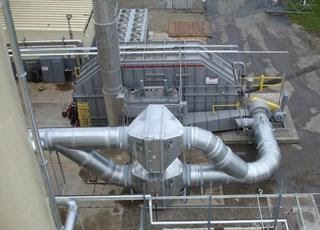 The Result
The Result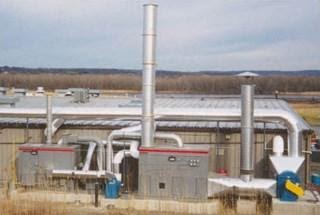 The Challenge
The Challenge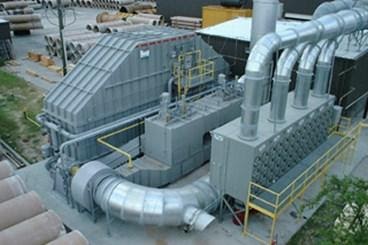 The Challenge
The Challenge